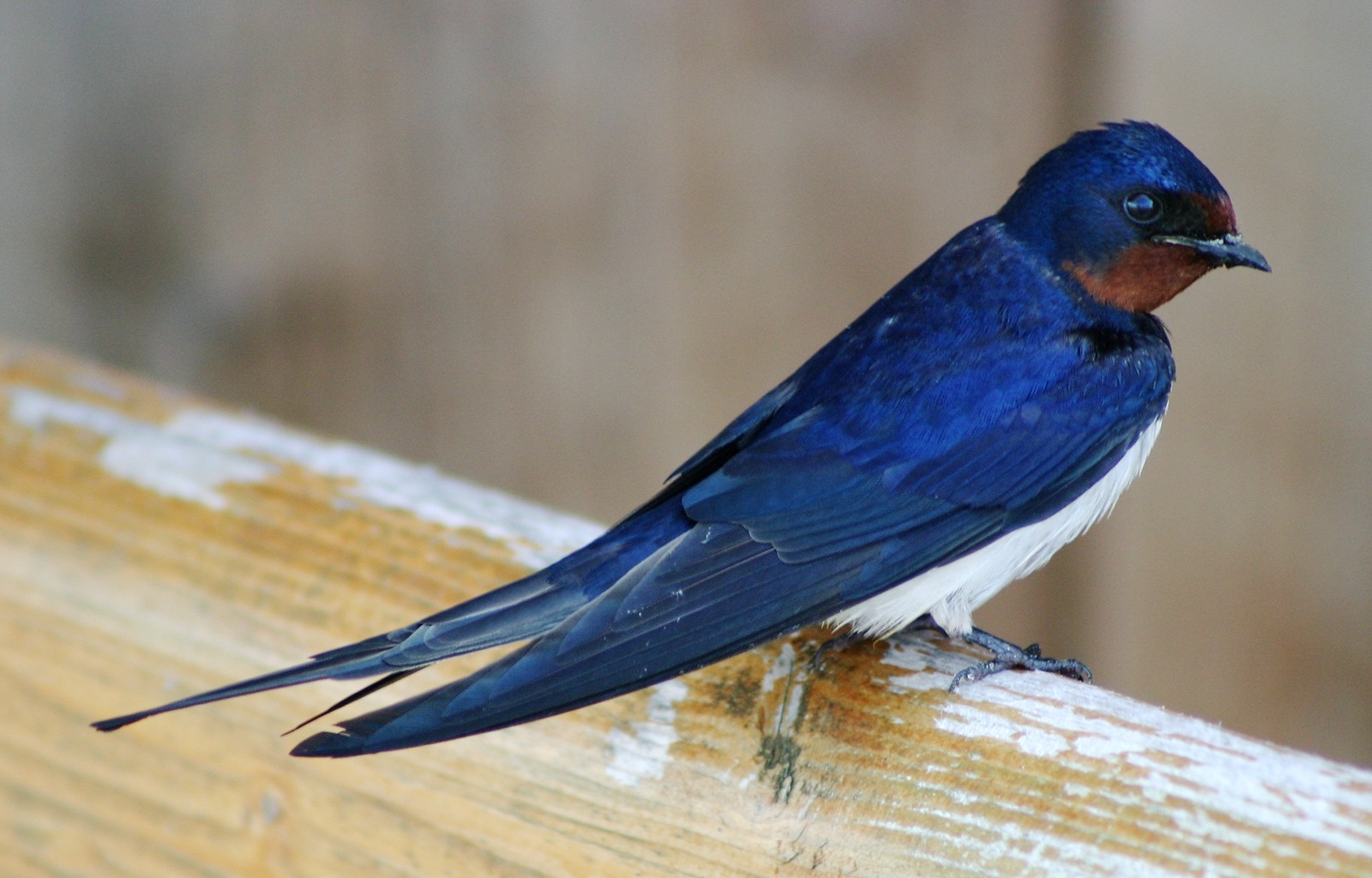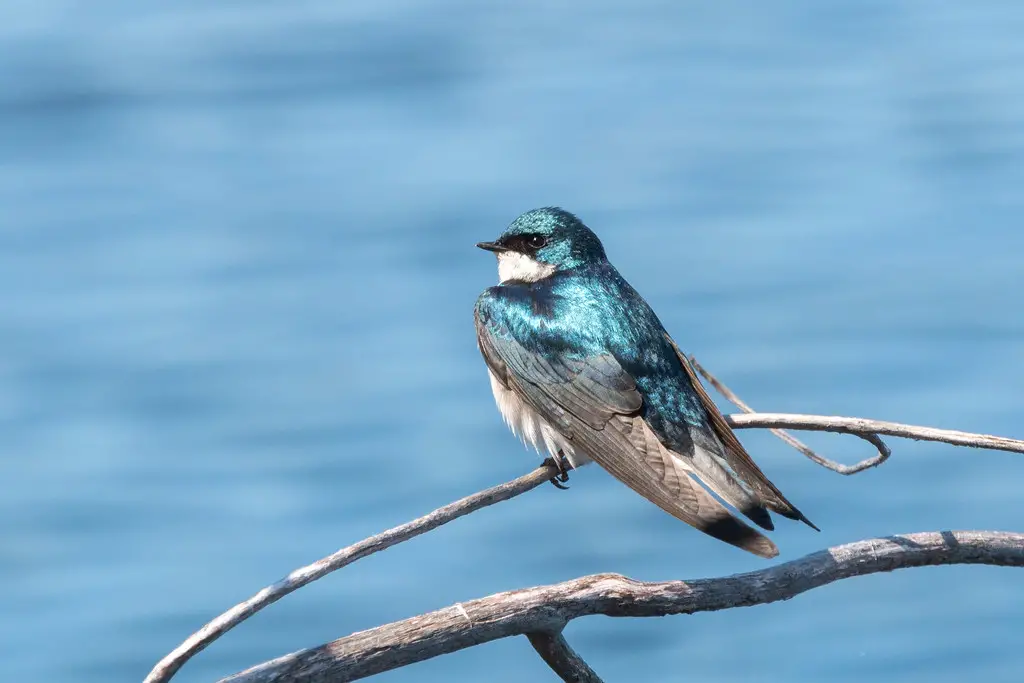Have you spotted a swallow in Florida recently and are curious about which type of swallow it might be?
Recognizing these swift and graceful birds in the Sunshine State can be more challenging than it appears. Florida is home to a variety of swallow species, making it quite a task to distinguish between them.
Fret not! This article is here to assist you. We’ll guide you through the most frequently encountered swallow species found in Florida. By the time you’re done reading, you’ll be armed with the knowledge to help you confidently identify the swallows you come across in the state. So, let’s dive into this informative exploration and get to know the diverse and captivating swallows of Florida!
List of Swallows Found in Florida
Purple Martin

- Scientific name: Progne subis
- Lifespan: 5 to 7 years
- Size: 7.5 to 8.5 inches
- Native to: North America
Purple Martin is the largest swallow in North America. Males have a dark purplish-blue color with an iridescent sheen, while females and juvenile birds are light gray on top with beige-white underparts. Unlike other martin species, the male Purple Martin lacks a light-colored belly. Originally, they built nests in tree cavities, but now they use man-made nesting sites, particularly in colonies that often comprise dozens of pairs. Purple Martins are skilled aerial hunters, primarily feeding on dragonflies. They drink in flight by skimming the surface of bodies of water. This bird is strictly migratory, spending the winter in South America and congregating in large roosts during fall migration. To attract them to your yard, you can put up a Purple Martin house.
Barn Swallow

Image Source
- Scientific name: Hirundo rustica
- Lifespan: 4 years
- Size: 5.5 and 7 inches
- Native to: Europe, Asia, Africa, and the Americas
Barn Swallow is a widespread bird that inhabits nearly all of North America south of the Arctic Circle. It is a breeding bird in northern Florida and is commonly encountered during migration throughout the rest of the state. Barn Swallows have dark iridescent blue upperparts and a reddish-orange underside, including a chestnut orange forehead and throat, as well as a light reddish-orange belly. Their deeply forked tail is a distinctive feature. While adults have a deeply forked tail, immature birds have shorter, less forked tails and duller plumage. Barn Swallows prefer nesting beneath the overhangs of buildings, bridges, and inside barns, which explains their name. Unfortunately, their overall numbers have been decreasing due to the loss of foraging areas and nesting opportunities. They feed on flying insects, such as mosquitoes and flies, and migrate south to Central and Southern America during the winter.
Northern Rough-winged Swallow

- Scientific name: Stelgidopteryx serripennis
- Lifespan: Typically 2-3 years
- Size: Small swallow; about 4.7-5.9 inches (12-15 cm) in length, wingspan of 10.2-10.6 inches (26-27 cm)
- Origin: Native to North and Central America, often found near water bodies and open areas.
Northern Rough-winged Swallow is a common breeding bird throughout North America during the summer. It has a uniformly light brown upper side and buff white underside, making it less colorful than other species of swallows. In Florida, it is a summer visitor in the northern part of the state and a winter visitor in the southern part. Along the Florida Gulf Coast, it is a year-round resident. These swallows prefer hunting over water, where they catch flying insects over rivers, lakes, and ponds. You can often see them resting on telephone wires or other exposed perches. They are burrow nesters, occupying abandoned cavities built by other birds. They migrate south during winter and spend the cold months in Southern Florida and Central America.
Cave Swallow

- Scientific name: Petrochelidon fulva
- Lifespan: Around 2-3 years
- Size: Small swallow; approximately 4.7-5.9 inches (12-15 cm) in length, wingspan of 11.4-11.8 inches (29-30 cm)
- Origin: Native to the Americas, including North America and parts of Central and South America.
Cave Swallow occurs in two subspecies, with one found in the southwest and the other in the Caribbean. The Caribbean subspecies breeds in South Florida and is darker than its western counterpart. It can be identified by its chestnut rump, forehead, and throat, which contrast with its dark blue back and cap. Originally nesting inside caves, they have adapted to breeding under Florida highway bridges, expanding their range northwards. They are colonial nesters, building large mud nests attached to the undersides of bridges and other structures. Cave Swallows are summer breeding visitors in Florida and spend the winter in Central America and the Caribbean.
Tree Swallow

- Scientific name: Tachycineta bicolor
- Lifespan: 5 years
- Size: 14 cm
- Native to: North America
Tree Swallow is relatively common in Florida during winter, often found near lakes, marshes, and ponds. Adult birds are greenish-blue on top with buff-white underparts, their iridescent feathers changing color in direct sunlight. Young individuals are more grayish-brown with a white underside. They accept suitable nesting boxes, making it possible to attract them to your backyard. Tree Swallows winter in Florida, around the Gulf of Mexico, and in Central America.
Cliff Swallow

- Scientific name: Petrochelidon pyrrhonota
- Lifespan: Typically 2-3 years
- Size: Small swallow; around 5.5-6.3 inches (14-16 cm) in length, wingspan of 11.4-12.2 inches (29-31 cm)
- Origin: Native to North and Central America, often nesting on cliffs and structures.
Cliff Swallow has a rust-red forehead and cheeks, and the rest of its plumage is mostly dark with a light cream-colored belly. The female looks similar to the male. Although it doesn’t nest in Florida, it is seen during migration in fall and spring. The Cliff Swallow prefers open country and bodies of water, foraging for flying insects. It is a long-distance migrant that spends its winter in South America, and during migration, it is often found in mixed flocks with other swallow species.
Bank Swallow

- Scientific name: Riparia riparia
- Lifespan: About 2-4 years
- Size: Small swallow; approximately 4.7-5.9 inches (12-15 cm) in length, wingspan of 9.8-10.6 inches (25-27 cm)
- Origin: Native to North America, Europe, and Asia, often nesting in sandy or earthen banks near water.
Bank Swallow is a breeding bird in Canada and northern US states but is regularly seen in Florida during migration in fall and spring. They are light brown on top and buff white on the belly, with a distinguishing brown band across the chest. They are often found in mixed flocks with other swallows during migration. The Bank Swallow has a global range but has undergone a steep decline in North America in recent years.
Final Thoughts on Swallows in Florida
As we conclude our journey through the world of swallows in Florida, we’ve unveiled the fascinating diversity that fills the skies of the Sunshine State. Identifying these agile and swift birds can indeed be a challenge, given the array of swallow species that call Florida home.
By delving into the most common swallows found in the state, we’ve equipped you with insights to help you distinguish between these avian wonders. Whether you’re gazing at a Barn Swallow’s forked tail or marveling at the Purple Martin’s vibrant plumage, you now have the tools to identify these birds with more confidence.


![Beautiful Pink Birds In Florida [Images + IDs]](https://birdsology.com/wp-content/uploads/2023/02/41-600x400.jpg)
![18 Stunning Blackbirds in Florida [Images + IDs]](https://birdsology.com/wp-content/uploads/2023/02/36-600x400.jpg)
![16 Beautiful Bluebirds In Florida [Images + Ids]](https://birdsology.com/wp-content/uploads/2023/02/42-600x400.jpg)
![Beautiful Shore Birds in Florida [With Images]](https://birdsology.com/wp-content/uploads/2023/08/sanderling-winter-dress-migratory-bird-sea-600x400.jpg)
